EDINBURGH (Part 1)
I got up early, trying not to disturb my fellow roommates, and walked into town. It wasn't that far... just a few blocks. Within a matter of minutes, I had left New Town and was gazing upon Old Town....
Edinburgh (pronounced by the locals as Edin-brah) is built on an area fused together by volcanic activity 350 million years ago. Castle Rock is an impressive 435-foot cliff in the center of the city. It has been used for thousands of years as a vantage point for defensive strongholds.
There is evidence of people inhabiting this area as far back as 900 BC although little is known about them. When the Romans invaded during the years 78 - 84, Castle Rock was held by a tribe of ancient Britons called the Votadini. Not much is known about them either other than that they are probably the ancestors of the Gododdin who eventually named the area Din Eidyn (or the Fort of Eidyn)... hence leading to the name of Edinburgh. Eventually the region fell to the Angles in 638 and was merged into the kingdom of Northumbria.
Four distinct groups once inhabited Scotland: the Picts in the north, the Britons in the southwest, the invading Angles in the southeast, and the Scots in the west. The Scots were Gaelic-speaking immigrants from the north of Ireland. Their king, Kenneth MacAlpin, acquired the Pictish throne in 843 and moved his capital into Pict territory. His great-great-great-grandsone defeated the Angles in 1018 and again the kingdom expanded, this time including the area of Edinburgh.
Over time Old Town became a cesspool, so New Town was built toward the close of the 18th century. The rich promptly moved, leaving Old Town to the poor. But it is in Old Town where most of the history still resides in the form of old buildings.

I was staying in 'new' New Town.

Click for a larger view
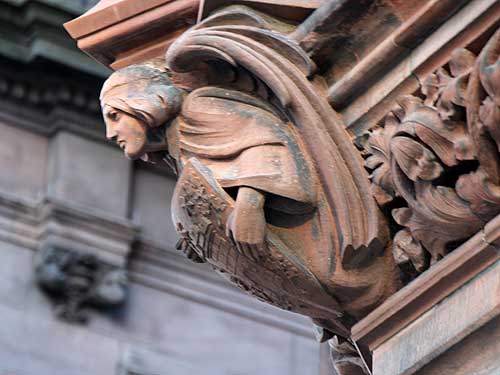
The morning light slowly began to awaken all the intricate carvings on the buildings.
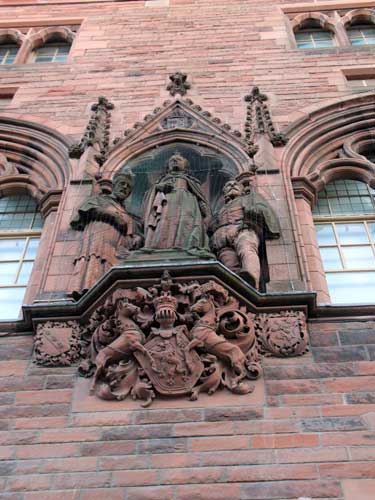
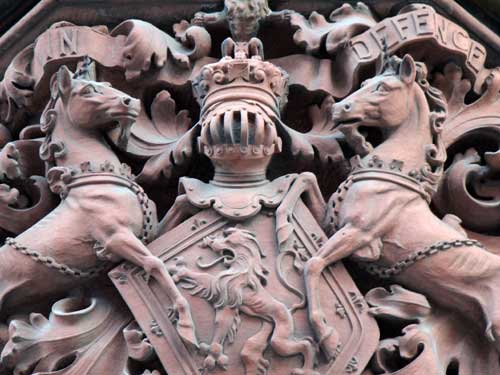
The unicorn is the official animal of Scotland and has been a symbol on family crests and coat of arms since the 12th century. Worshipped since the ancient Babylonians, this magical creature had a horn that could heal disease. In the Celtic stories, the unicorn symbolized innocence, purity, joy and power. The animals are often wrapped in chains, because according to legend, a free unicorn was very dangerous.
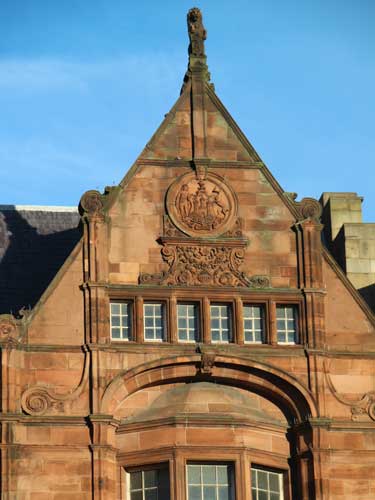
The stones begins to glow as beautifully as the rising sun.
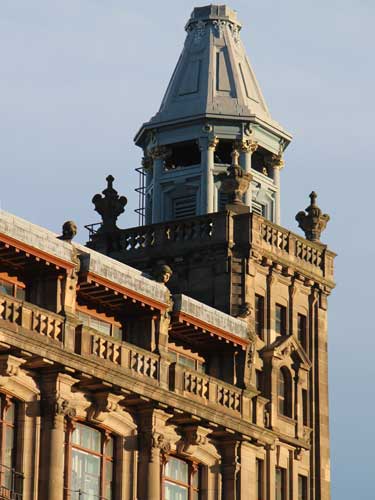
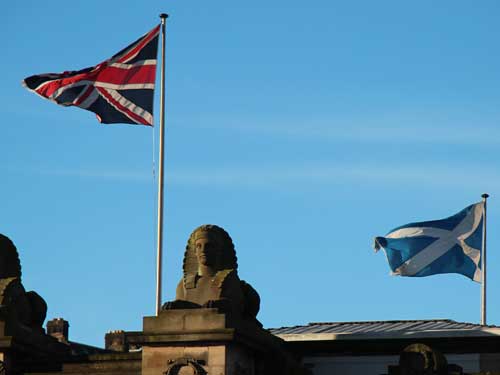
The Union Jack (the flag of the United Kingdom) and the Saltire (the national flag of Scotland) wave side by side.
I arrived at Princes Street and was immediately greeted by the Scott Monument. This lovely structure honors Sir Walter Scott (1771 - 1872), one of Scotland's greatest novelists. This lovely structure honors Sir Walter Scott (1771 - 1872), one of Scotland's greatest novelists. It is just over 200 feet tall and there are 287 steps to the top. Inside (somehow) was supposedly a museum but nothing was open.
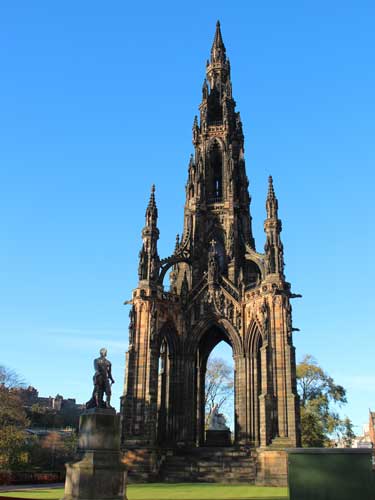
Construction, which began in 1840, lasted about four years.
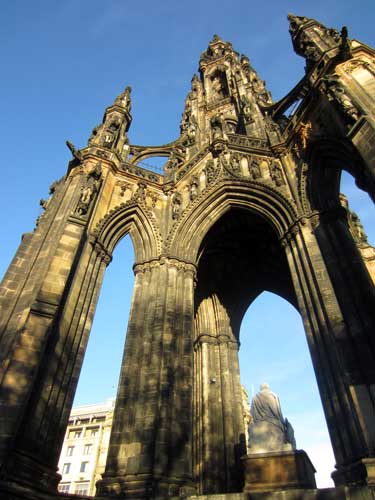
The style of Victorian Gothic (also Gothic Revival or Neo-Gothic) began in the late 1740's in England and its popularity grew rapidly.

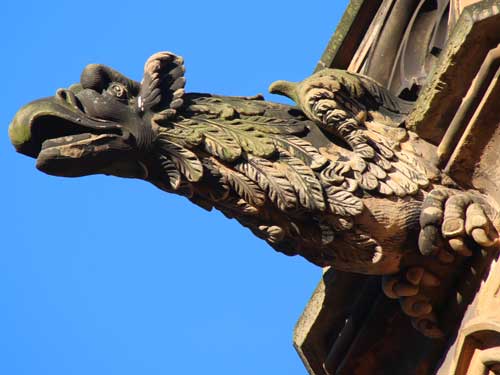
Scary gargoyles covered the walls.
The gargoyle's main purpose is to act as a water spout or protruding gutter from the roof to prevent rainwater from running down the sides of the building and eroding the mortar. The term comes from the French gargouille, which means throat or gullet. The root 'gar' means to swallow (think of the word 'gargle').
So why are they so scary? Supposedly they also served a second function of frightening off harmful spirits, thereby protecting the building that it guards (although it also didn't hurt that they often scared the heck out the common people to send a strong message about the dangers of 'evil'). An old French legend tells of a dragon that used to roam the countryside around Rouen. It had bat-like wings and could breathe fire. Eventually it was captured and let back to the city to be burned. But because it was capable of breathing fire, its head and neck wouldn't burn. So it was mounted to the walls of the newly built church.
Nowadays, they range from scary to funny, from people (such as monks) to chimeras (unusual animal mixtures)... or a bizarre combination of the two. Not all of them acted as rain gutters and were simply for ornamentation. These are more properly referred to as grotesques instead of gargoyles.
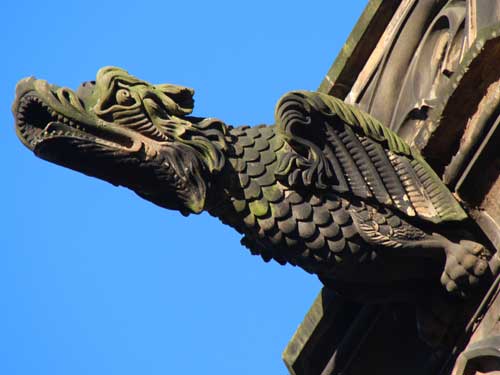
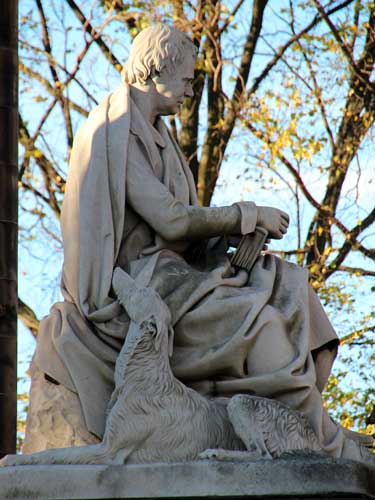
Sir Walter Scott himself, apparently in a rather pensive mood
I was now able to learn about the small field of crosses on the far side of the monument, that I had briefly seen upon my arrival. This is the Fields of Remembrance. While there are similar such fields in the rest of England, this is the first one in Scotland, having opened in November of 2011.
I had seen the Poppys at work in New Zealand before. Wearing dark caps with a bright red flower, they were collection donations for the Royal British Legion... for those who serve in it, veterans, injured members, etc. and their families to help with a variety of difficulties ranging from financial to emotional.

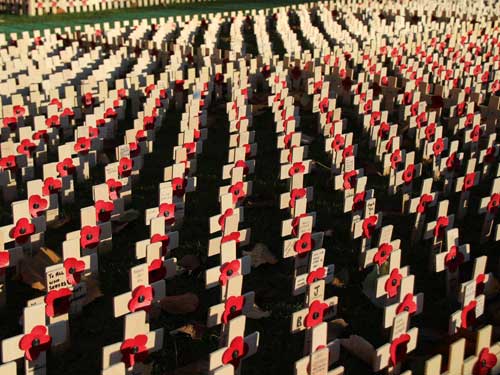
Each of the 11,000 small wooden crosses were handmade by disabled veterans and had a poppy and a message of thanks and remembrance to those who gave their lives for Scotland and the whole of the United Kingdom.
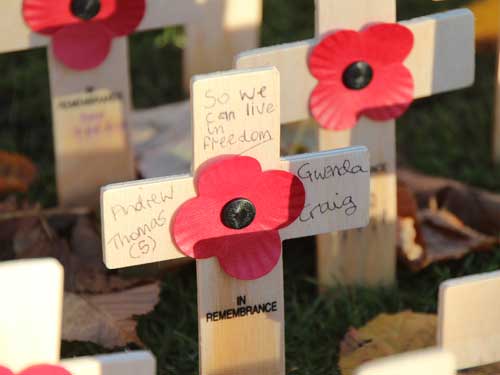
"So we can live in freedom"
The path continued on, leading me past many statues with names such as Adam Black (1784 - 1874) and John Wilson (1785 - 1854).
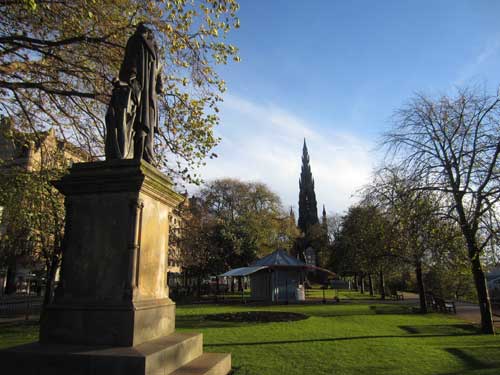
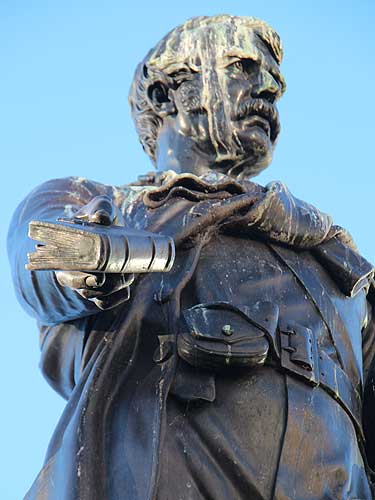
Poor Mr. Livingstone. The birds have not been kind. David Livingstone (1813 - 1873) was a medical missionary and an explorer in Africa. Yes, he is the dude from the quote: "Dr. Livingstone, I presume?"
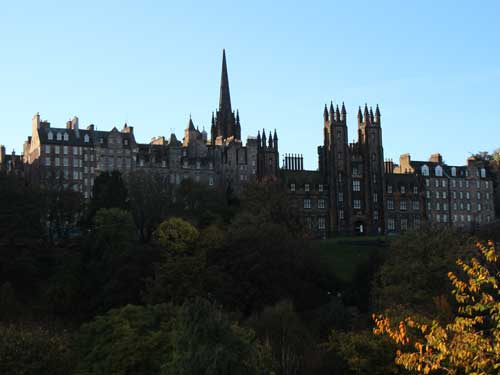
My first clear glimpses of Old Town through the trees
I made my way past the Scottish National Gallery and entered Princes Street Gardens.
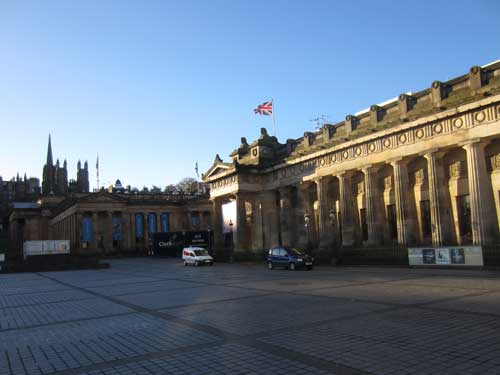
The gallery
The public park, located in the center of town, was created following the draining of Nor Loch (North Lake) and the building of New Town. The loch had become extremely polluted from sewage draining downhill from Old Town.
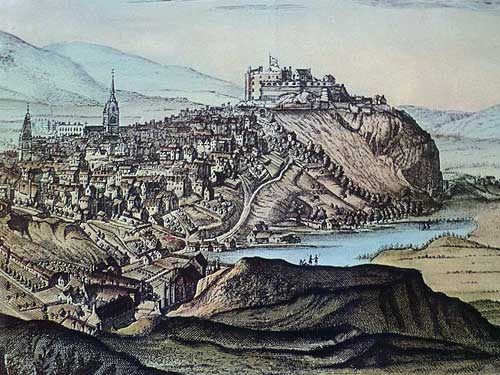
Edinburgh Castle with the Nor Loch in the foreground, c.1690 - part of an engraving by John Slezer Nor Loch was initially a marsh. In 1460 King James III ordered it to be flooded (by use of an earthen dam to block the stream) in order to strengthen the castle's defenses. The water level was controlled by the dam. While it was initially a great hinderance to invaders (except in the winter when it froze), it was also a hinderance to town growth. The first draining ocurred in 1763, followed by the rest in 1820.
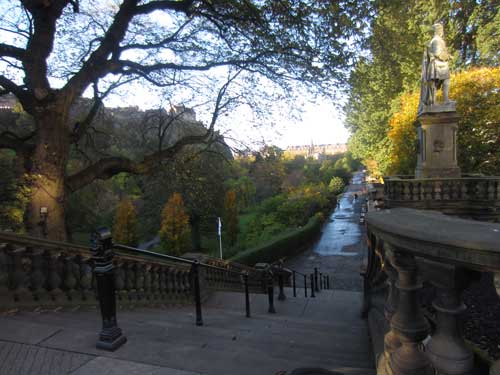
Entering the garden

Looming above the park was Edinburgh Castle.

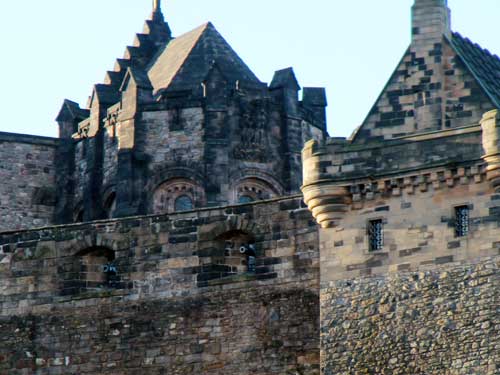
Cannons could still be seen poking through the walls.
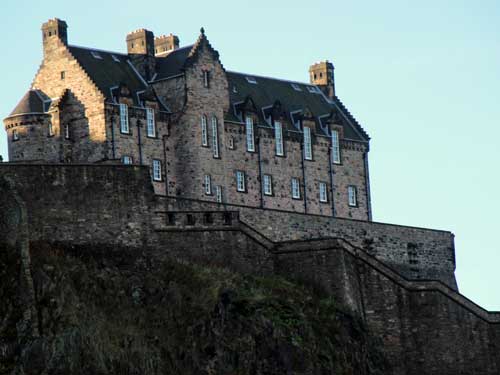
In and along the gardens were numerous statues and war monuments.
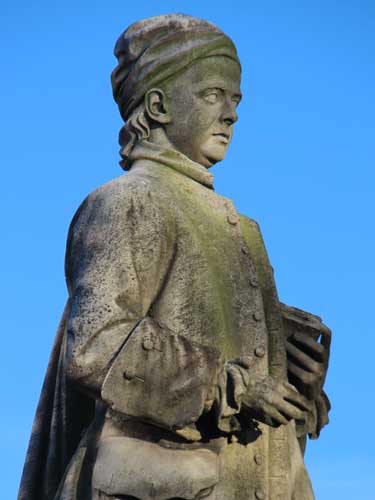
Allan Ramsay (1686 - 1758) was a poet, playwright, publisher, librarian... and wig-maker.
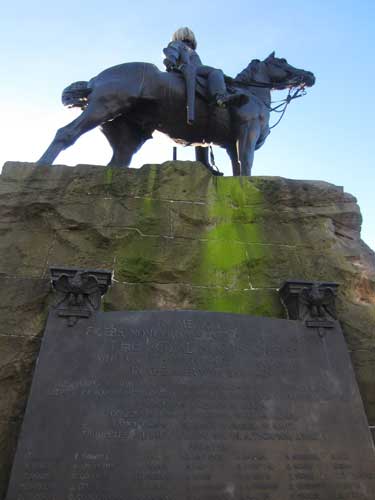
The Royal Scots Greys Memorial... honoring both the Boer War (1899 - 1902)...
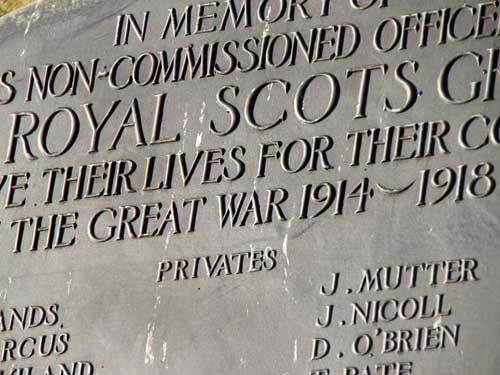
... and The Great War (or WWI as it was called before there was a second one).
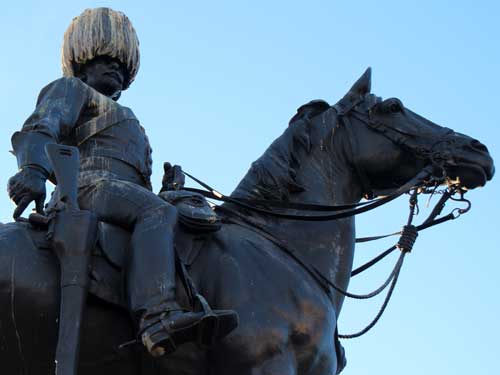
They were a cavalry regiment of the British Army from 1707 - 1971.
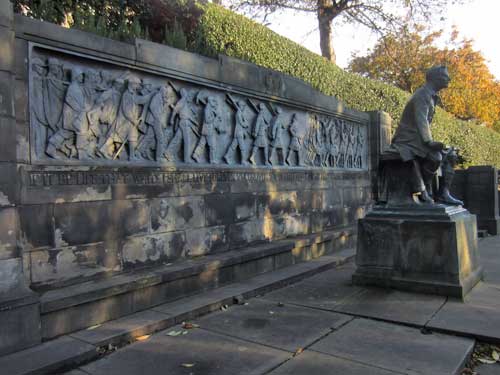
The Scottish American War Memorial (or "The Call 1914") was given by Scottish Americans in 1927 to honor Scots who fought in WWI. It took four years to make.

A kilted infantry man looks towards Castle Rock.
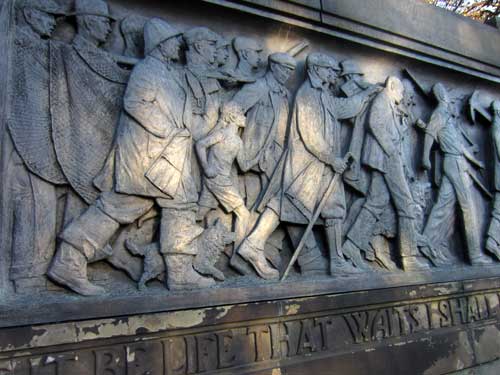
The bronze frieze shows Scots of differing professions answering the call of war and changing from civilians into marching soldiers. At the bottom are lines from Lieutenant Ewart Alan Mackintosh's poem "A Creed"... "If it be life that waits, I shall live forever unconquered. If death, I shall die at last, strong in my pride and free." Mackintosh was a university student who was killed at the second Battle of Cambrai (1917) at the age of 23.
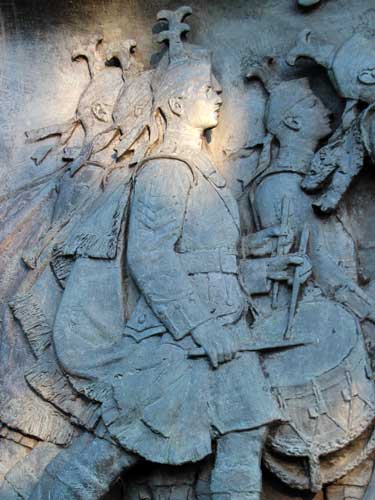
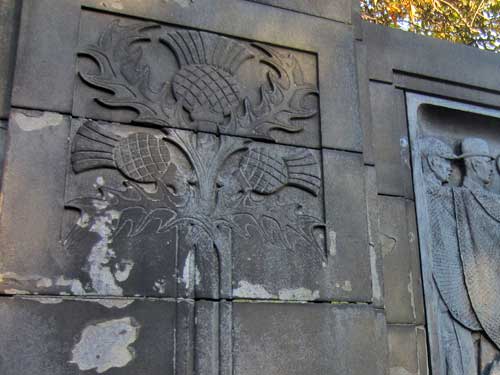
The thistle is Scotland's floral emblem. No one really knows why this is so, but one legend tells of how a group of sleeping Scottish warriors were saved from an ambush by a Norse army when one of the attackers stepped on a thistle with his bare feet and cried out, thus awaking the Scots who promptly defeated the invaders. True? It probably doesn't matter at this point, but it is still a nice story.
At the far end of the park stood The Parish Church of St. Cuthbert. I slipped past and entered the large cemtery behind it.
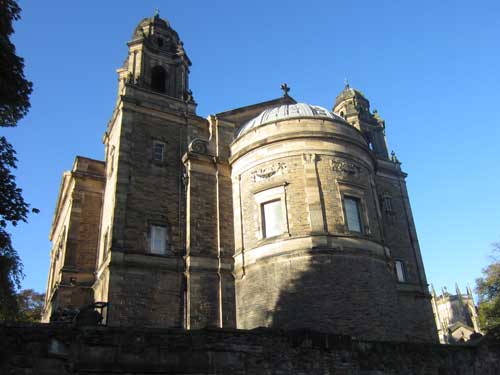
The steeple (not visible in this picture) dates from 1789 while the rest of the building was completed in 1894. A building or chapel of some kind has stood in this very spot since the 8th century.
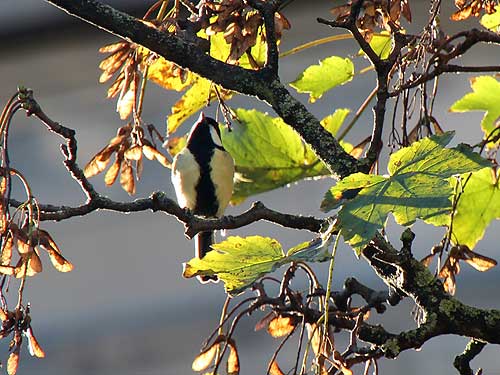
The Great Tit is a small songbird that is widespread throughout Europe, Asia and parts of northern Africa. During the summer it mostly eats insects, but during winter, anything is possible... including small hibernating bats! It has adapted well to humans and is a common site in urban parks and gardens. The Great Tit has up to 40 types of calls and songs. One call sounds like a squeaky wheelbarrow while another (that an old wives' tale claims foretells of rain) is more like the sharpening of a saw.

